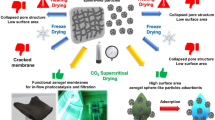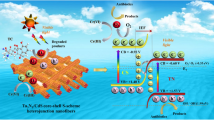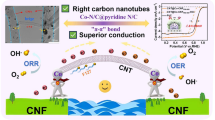Abstract
Porous composite nanofibers consisted of cubic Bi12TiO20, and orthorhombic Bi4Ti3O12 with pore size of 5–10 nm have been successfully synthesized by combining electrospinning with calcination for photodegrading methyl orange (MO). Calcination temperature has a great effect on the ratio of Bi12TiO20 and Bi4Ti3O12 and their morphology, which in turn affects the photocatalytic property of the products. MO was almost completely degraded over the as-prepared samples obtained under the optimizing calcination temperature of 500 °C after irradiating for 40 min under simulated sunlight. Besides, cycle and regeneration experiments show that the porous Bi12TiO20/Bi4Ti3O12 composite nanofibers possess fine cycle stability and regeneration ability, after the regenerative photocatalyst was recycled twice, 91% of the MO was degraded. Based on the characterization results, the mechanism of the improvement in photocatalytic property of Bi12TiO20/Bi4Ti3O12 composite nanofibers was also investigated, and h+ played a major role in the photodegradation of MO. In addition, the as-prepared Bi12TiO20/Bi4Ti3O12 composite nanofibers show a certain capacity of photocatalytic hydrogen production under the simulated sunlight. This work not only provides a porous fiber with good photocatalytic activity, but also provides a reference for the preparation and performance study of other fibers.








Similar content being viewed by others
References
Fuhrman F, Tal VA, Arnon S (2015) Why endocrine disrupting chemicals (EDCs) challenge traditional risk assessment and how to respond. J Hazard Mater 286:589–611
Wang MJ, Shen SL, Li L, Tang ZH, Yang JH (2017) Effects of sacrificial reagents on photocatalytic hydrogen evolution over different photocatalysts. J Mater Sci 52:5155–5164. https://doi.org/10.1007/s10853-017-0752-z
Ho WK, Zhang ZZ, Lin W, Huang SP, Zhang XW, Wang XW, Huang Y (2016) Copolymerization with 2,4,6-triaminopyrimidine for the rolling-up the layer structure, tunable electronic properties, and photocatalysis of g-C3N4. Appl Mater Interfaces 7:5497–5505
Wan S, Zhong Q, Ou M, Zhang S (2017) Synthesis and characterization of direct Z-scheme Bi2MoO6/ZnIn2S4, composite photocatalyst with enhanced photocatalytic oxidation of NO under visible light. J Mater Sci 52(19):11453–11466. https://doi.org/10.1007/s10853-017-1283-3
Dong R, Hu Y, Wu Y, Gao W, Ren B, Wang Q, Cai Y (2017) Visible-light-driven BiOI-based janus micromotor in pure water. J Am Chem Soc 139:1722–1725
Guo YN, Chen L, Yang X, Ma FY, Zhang SQ, Yang YX, Guo YH, Yuan X (2012) Visible light-driven degradation of tetrabromobisphenol A over heterostructured Ag/Bi5Nb3O15 materials. RSC Adv 2:4656–4663
Gu SN, Li WJ, Wang FZ, Wang SY, Zhou HL, Li HD (2015) Synthesis of buckhorn-like BiVO4 with a shell of CeOx nanodots: effect of heterojunction structure on the enhancement of photocatalytic activity. Appl Catal B 170–171:186–194
Dong SY, Ding XH, Guo T, Yue XP, Han X, Sun JH (2017) Self-assembled hollow sphere shaped Bi2WO6/RGO composites for efficient sunlight-driven photocatalytic degradation of organic pollutants. Chem Eng J 316:778–789
Xie R, Zhang L, Xu H, Zhong Y, Sui XF, Mao ZP (2017) Construction of up-converting fluorescent carbon quantum dots/Bi20TiO32, composites with enhanced photocatalytic properties under visible light. Chem Eng J 310:79–90
Jiang J, Zhao K, Xiao XY, Zhang L (2012) Synthesis and facet-dependent photoreactivity of BiOCl single-crystalline nanosheets. J Am Chem Soc 134:4473–4476
Yin S, Di J, Lin M, Sun YL, Xia JX, Xu H, Fan WM, Li HM (2016) Ionic liquid-assisted synthesis and improved photocatalytic activity of p–n junction g-C3N4/BiOCl. J Mater Sci 51(10):4769–4777. https://doi.org/10.1007/s10853-016-9746-5
Li H, Liu J, Hou W, Du N, Zhang RJ, Tao XT (2014) Synthesis and characterization of g-C3N4/Bi2MoO6, heterojunctions with enhanced visible light photocatalytic activity. Appl Catal B Environ 160:16189–16197
Xu BY, An Y, Liu YY, Qin XY, Zhang XY, Dai Y, Wang ZY, Wang P, Whangbo MH, Huang BB (2017) Enhancing the photocatalytic activity of BiOX (X = Cl, Br, I), (BiO)2CO3 and Bi2O3 by modifying their surfaces with polar organic anions, 4-substituted thiophenolates. J Mater Chem A 5:14406–14414
Babu V, Bhavatharini RS, Ramakrishna S (2014) Bi2O3 and BiOCl electrospun nanosheets and morphology-dependent photocatalytic properties. RSC Adv 4:29957–29963
Zhang M, Liu Y, Li L, Gao H, Zhang XT (2015) BiOCl nanosheet/Bi4Ti3O12, nanofiber heterostructures with enhanced photocatalytic activity. Catal Commun 58:122–126
Guo W, Zhang S, Guo Y, Ma L, Su F, Guo YH, Geng AF (2013) Template-free and morphology-controlled hydrothermal growth of single-crystalline Bi12TiO20 with excellent simulated sunlight photocatalytic activity. RSC Adv 3:4008–4017
Zhang HP, Lv MK, Liu SW, Wang LY, Xiu ZL, Zhou YY, Qiu ZF, Zhang AY, Ma Q (2009) Preparation and photocatalytic property of perovskite Bi4Ti3O12 films. Mater Chem Phys 114(2–3):716–721
Du C, Li DH, He QY, Liu JM, Li W, He GN, Wang YZ (2016) Design and simple synthesis of composite Bi12TiO20/Bi4Ti3O12 with a good photocatalytic quantum efficiency and high production of photo-generated hydroxyl radicals. Phys Chem Chem Phys 18:26530–26538
Li D, Xia Y (2010) Electrospinning of nanofibers: reinventing the wheel. Adv Mater 16(14):1151–1170
Wu L, Lang J, Wang R, Guo R, Yan X (2016) Electrospinning synthesis of mesoporous MnCoNiOx@double-carbon nanofibers for sodium ion battery anode with pseudocapacitive behavior and long cycle life. ACS Appl Mater Interfaces 8(50):34342
Wei W, Dai Y, Huang B (2009) First-principles characterization of bi-based photocatalysts: Bi12TiO20, Bi2Ti2O7, and Bi4Ti3O12. J Phys Chem C 113:5658–5663
Song G, Li Z, Li K, Zhang L, Meng AL (2017) SiO2/ZnO composite hollow sub-micron fibers: fabrication from facile single capillary electrospinning and their photoluminescence properties. Nanomaterials 7(3):53
Zhao W, Jia Z, Lei E, Wang L, Li Z, Dai Y (2013) Photocatalytic degradation efficacy of Bi4Ti3O12 micro-scale platelets over methylene blue under visible light. J Phys Chem Solids 74(11):1604–1607
Kossanyi J, Kouyate D, Pouliquen J, Ronfard-Haret JC, Valat P (1990) Photoluminescence of semiconducting zinc oxide containing rare earth ions as impurities. J Lumin 46(1):17–24
Georgekutty R, Seery MK, Pillai SC (2008) A highly efficient Ag–ZnO photocatalyst: synthesis, properties, and mechanism. J Phys Chem C 112(2008):13563–13570
Huo Y, Zhang J, Miao M, Jin L (2012) Solvothermal synthesis of flower-like BiOBr microspheres with highly visible-light photocatalytic performances. Appl Catal B 111(3):334–341
Gnayem H, Sasson Y (2013) Hierarchical nanostructured 3D flowerlike BiOClxBr1−x semiconductors with exceptional visible light photocatalytic activity. ACS Catal 3:186–191
Lei L, Jin H, Zhang Q, Xu J, Gao D, Fu ZY (2015) A novel enhanced visible-light-driven photocatalyst via hybridization of nanosized BiOCl and graphitic C3N4. Dalton Trans 44(2):795–803
Acknowledgements
The work reported here was supported by the National Natural Science Foundation of China under Grant Nos. 51672144, 51572137, 51502149, 51702181, the Natural Science Foundation of Shandong Province under Grant Nos. ZR2016EMB25, ZR2017PEM006, ZR2017BB013, the Higher Educational Science and Technology Program of Shandong Province under Grant Nos. J16LA10, J17KA014, the Application Foundation Research Program of Qingdao under Grant No. 15-9-1-28-jch, the Taishan Scholars Program of Shandong Province under No. ts201511034 and the Overseas Taishan Scholars Program. We express our grateful thanks to them for their financial support.
Author information
Authors and Affiliations
Corresponding author
Electronic supplementary material
Below is the link to the electronic supplementary material.
Rights and permissions
About this article
Cite this article
Meng, A., Xing, J., Guo, W. et al. Electrospinning synthesis of porous Bi12TiO20/Bi4Ti3O12 composite nanofibers and their photocatalytic property under simulated sunlight. J Mater Sci 53, 14328–14336 (2018). https://doi.org/10.1007/s10853-018-2628-2
Received:
Accepted:
Published:
Issue Date:
DOI: https://doi.org/10.1007/s10853-018-2628-2




